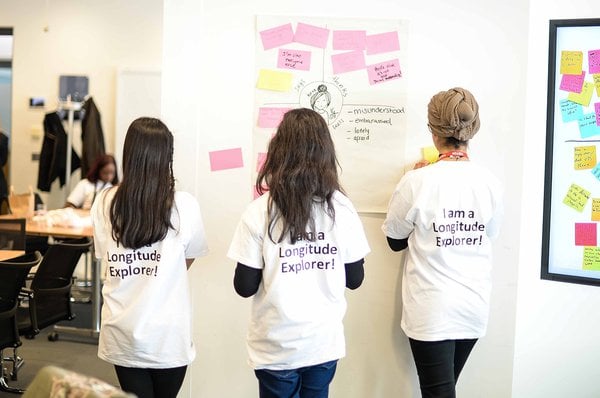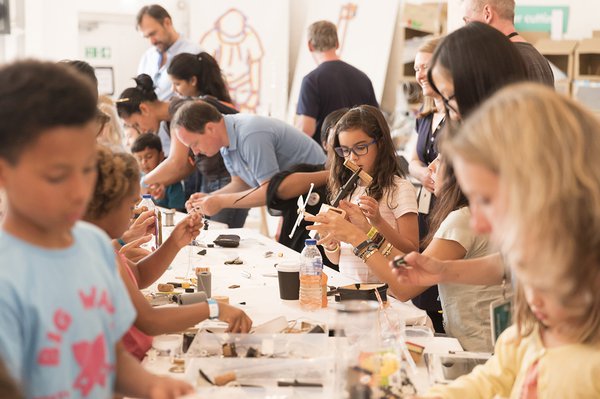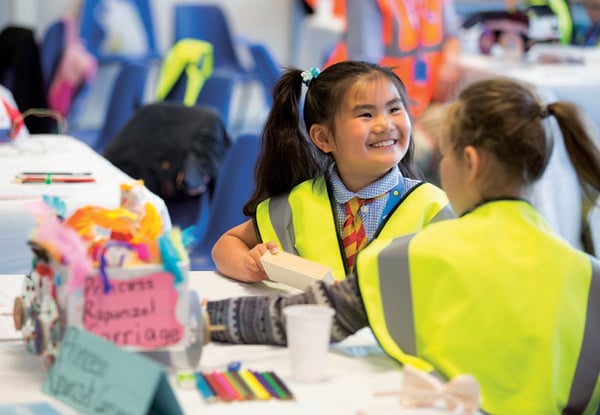So what is being done to help young people become the innovators of the future? We found 29 schemes around the UK that aim to give children ‘exposure to innovation’.

The creators of SeeO2, a device that connects to your phone and measures air quality. Runners-up in the Longitude Explorer Prize 2017.
Mapping invention schemes
We worked with AlphaPlus to map initiatives that aim to give children and young people ‘exposure to innovation’. We combined online searches, expert interviews and open calls on social media and through our networks, to try and find as much of this activity as possible.
Drawing on what we had learned from the literature, we were interested in schemes that could help to build children’s ‘capital’ relating to innovation. We reasoned that this might include:
- Helping children to meet inventors (who you know)
- Building their skills and knowledge relating to invention (what you know)
- Changing perceptions about who can be an inventor (how you think)
- Helping children get practical experience of inventing (what you do) [24]
A key challenge in finding relevant schemes was in deciding where to draw the boundaries between ‘invention’ and other related activities. We found a lot of interventions focusing on STEM (science, technology, engineering and maths), enterprise, and skills such as creativity or problem solving. All of these could help prepare young people to be innovators, because they all aim to develop skills, knowledge and competencies that are relevant to innovation. A strong knowledge base in STEM subjects, for example, is important for technological invention.
However, as we argue in the previous section, academic literature on this subject points to the importance of very specific information and networks in shaping people’s likelihood to be an inventor. The ‘lost Einsteins’ study, for example, shows that growing up in an area where there is a concentration of patenting activity in a particular field makes people more likely to patent in exactly that field.
For this study, therefore, we focused on schemes that have a ‘strong’ focus on exposure to innovation. We classified schemes in this way if they addressed at least one of the goals listed above and if invention was a central focus, rather than one of several possible objectives. Most of these schemes used the terms ‘invention’ or ‘innovation’ in the way they described their aims and activities. For this study, we focused on schemes involving direct interaction with individuals (i.e. those that were not simply marketing campaigns or products).
We judged 29 schemes to have a ‘strong’ focus on exposure to innovation, meeting the criteria above. We reflect below on the schemes that met some, but not all, of our criteria - the wider landscape of provision that is relevant to, but not directly focused on, invention.
The fact that these schemes are hard to identify also indicates to us that there is a need for more coordination and visibility for activity like this. We return to this point in our recommendations.

The Institute of Imagination provides inspiring creative experiences for families and children
What types of schemes did we find?
We found that competitions are the most common type of scheme. Children usually work on ‘challenges’ as teams, supported by teachers, and can submit their entries to local, national or even international judging panels. For example, 3M Young Innovators Challenge offers students in Berkshire, Leicestershire and Nottinghamshire the opportunity to take part in challenges tailored to different age groups - primary school students, for instance, can take part in the Eco Tech Challenge, where they design and construct a functioning musical instrument made entirely from recycled materials. Nesta’s Longitude Explorer Prize has a different focus each year. Its most recent iteration tasked young people with developing innovative, practical solutions using the Internet of Things (IoT) to improve health and wellbeing in the UK.
Some competitions are open for children to enter directly, rather than running through schools. Equinor’s Young Imagineers, for example, is run in partnership with the Science Museum, and invites children to come up with an invention to ‘make tomorrow's world a better place’. Children are asked to draw a sketch of their invention, along with a short description of what it does, with entries judged by a panel of leading inventors.
We found some expert-designed projects and courses designed to complement the school curriculum. Fixperts projects challenge young people to research and develop solutions to problems they have identified, sketch out ideas, model prototypes and make a final product. Fixperts aims to integrate design and technology, engineering thinking and practical making skills and allows students to develop their creative skills through hands on model making while learning to improve their ideas through feedback. Apps for Good is a technology education programme in which students create mobile apps and IoT products that solve a social problem. It provides free courses for teachers to use as part of the curriculum, as enrichment, or as a club.
One-day activities give children a ‘taster’ of invention. Examples include the Engineering Development Trust’s First Edition Days, during which children design, build and test a model, putting their STEM knowledge into practice on themes like renewable energy. Little Inventors takes a different approach, focusing on creativity and imagination. It gets children to come up with an idea and draw a picture of their invention - some of these ideas are later turned into real models and products by professional makers and artists.
Outside of school, some clubs and holiday camps give children an opportunity to further develop their skills for invention. FixCamp, Fixperts’ summer camp, ran in London for the first time in 2018, focused on making. Institute of Imagination runs summer workshops covering design, electronics, mechanics and programming, also in London. MakerClub runs weekend and after-school sessions in innovation centres, colleges and community spaces in Brighton, Bournemouth, Birmingham, Norwich and London also sells ‘invention kits’ for children to use at home.
Children can get access to role models and employers through schemes like In2Science, which helps children to meet people working in STEM roles and organises work experience. Younger children entering the Primary Engineer Leaders Award are encouraged to interview an engineer, and then submit an idea for something an engineer could build to solve a problem. Apps for Good and Fixperts both convene networks of experts to support activity in schools. Schools delivering Apps for Good courses, for example, can book ‘expert sessions’ where industry experts dial into a classroom for an hour and talk with the students. In Northern Ireland, Generation Innovation - Reimagining Work Experience, piloted in 2018, gave 60 pupils from 32 schools the chance to work with innovative companies to "solve real business challenges using ‘design-thinking’ methods". Several competitions involve awards days where shortlisted teams get to meet ‘real life’ inventors.
Most schemes we found are aimed at children, but some also offer activities for families and communities. The Engineering Development Trust hosts Family Challenge events, which provide an opportunity for schools and companies to build and enhance relationships with young people and family members. Institute of Imagination runs one-day family workshops. SMASHfest is a community festival designed to widen participation and build diversity in STEM using the arts - it has run annually in south east London for four years, with the most recent edition attended by 4,000 people.
See our selection of case studies to learn more about invention schemes.
Invention sits in a wider field of related activity
Beyond our 29 ‘high-relevance’ schemes, we found more than 50 further interventions that met some, but not all, of our criteria. These included schemes that focus on teaching skills like coding or making, but did not have a strong emphasis on problem solving and creating something new. We did not include any enterprise programmes in our final list because in all of those we reviewed, innovation was a minor objective (they focused more on entrepreneurship, business skills and pitching). Since STEM competitions and challenges were such a common model, we searched for as many of these as we could find, and then rated them for their focus on invention. Where competitions revolved more around research projects, or building things like model cars to a predefined design, we left these out.
However, it is clear that there is a wider field of activity that touches on invention, even if it is not a primary focus. In our recommendations, we argue that making invention a stronger part of these schemes could help significantly expand the opportunities available to children.
For example, we found a wide range of activities to promote engagement, interest and attainment in STEM. Some give access to role models (e.g. STEM Ambassadors) while others encourage young people to apply STEM knowledge in practice (e.g. the Formula 1 in Schools STEM Challenge). Several organisations offer professional development for STEM teachers (e.g. Primary and Secondary Engineer’s CPD programme). Through the British Science Association CREST Awards, pupils can receive accreditation for their participation in practical STEM activities tailored for different age ranges.
Some of these centre around increasing diversity in STEM. Stemettes, for example, runs public workshops and events, a mentoring scheme and school trips, focused on inspiring girls and young women into careers in STEM. The Science Capital Teaching Approach is a teaching resource that aims to help more — and more diverse — students engage with science, based on the science capital model. The Institute of Physics Whole School Equality Programme supports schools to make small changes across the curriculum and school environment, to try to make big changes in gender equality across all areas of school life.
The Association of Science and Discovery Centres runs a network of over 60 centres across the UK, which receive more than 20 million visitors a year; half are estimated to be school-age children. The network, which includes the UK’s major science museums and learned societies, aims to inspire and engage local communities in science: several of the institutions have particular research interests (eg. the National Space Centre in Leicester, or the Centre of the Cell in London, which focuses on biomedical research), and organise activities around these themes. Many deliver particular national programmes, developed centrally by the Association and then opened for bidding between centres.
Nesta has previously mapped activities focusing on digital making, which help young people learn skills to be active users of digital technologies. These range from large-scale programmes like Code Club, now reaching over 100,000 children through after-school coding clubs, to more local initiatives like Curiosity Hub, based in Brighton and Hove, which runs one-day STEAM enrichment workshops in schools, as well as public workshops open to all.
Enterprise initiatives like the Young Enterprise Fiver and Tenner challenges, Tycoon in Schools and the Ryman National Enterprise Challenge teach young people business and entrepreneurship skills, incorporating an element of innovation.
Meanwhile, there are many schemes that promote skills and competencies important for future jobs that are relevant for innovation, such as collaborative problem-solving, creativity and resilience. Some schools have even made these central to their teaching approaches: XP is an 11-19 mainstream secondary school in Doncaster, UK and is part of the XP Multi-Academy Trust. It organises teaching around ‘expeditions’ that encourage students to come up with creative solutions to real-world issues and problems.
[24] Here we took inspiration from the Lemelson Foundation, and defined ‘inventing’ as including identifying problems and possible solutions, and turning ideas into reality through designs, prototypes and entrepreneurial thinking.










